.gif)
St. Sebastian (Mantegna)
Encyclopedia
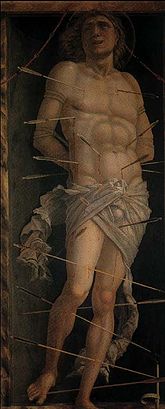 |
| St. Sebastian |
| Andrea Mantegna, 1490 |
| Panel, 68 × 30 cm |
| Ca' d'Oro Ca' d'Oro Ca' d'Oro is a palace on the Grand Canal in Venice, northern Italy. One of the older palazzi, it has always been known as Ca' d'Oro due to the gilt and polychrome external decorations which once adorned its walls.The Palazzo was built between 1428 and 1430 for the Contarini family, who provided... , Venice |
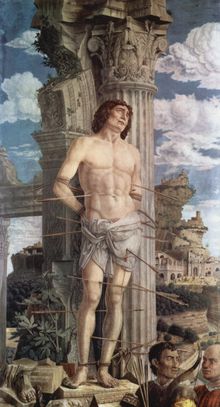 |
| St. Sebastian |
| Andrea Mantegna, 1480 |
| Canvas, 255 x 140 cm |
| Musée du Louvre, Paris |
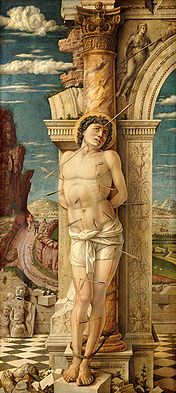 |
| St. Sebastian |
| Andrea Mantegna, 1456–1459 |
| Panel, 68 × 30 cm |
| Kunsthistorisches Museum Kunsthistorisches Museum The Kunsthistorisches Museum is an art museum in Vienna, Austria. Housed in its festive palatial building on Ringstraße, it is crowned with an octagonal dome... |
St. Sebastian is the subject of three paintings by the Italian Early Renaissance
Renaissance
The Renaissance was a cultural movement that spanned roughly the 14th to the 17th century, beginning in Italy in the Late Middle Ages and later spreading to the rest of Europe. The term is also used more loosely to refer to the historical era, but since the changes of the Renaissance were not...
master Andrea Mantegna
Andrea Mantegna
Andrea Mantegna was an Italian painter, a student of Roman archeology, and son in law of Jacopo Bellini. Like other artists of the time, Mantegna experimented with perspective, e.g., by lowering the horizon in order to create a sense of greater monumentality...
. The Paduan artist lived in a period of frequent plagues; Sebastian was considered protector against the plague as having been shot through by arrows, and it was thought that plague spread abroad through the air.
In his long stay in Mantua
Mantua
Mantua is a city and comune in Lombardy, Italy and capital of the province of the same name. Mantua's historic power and influence under the Gonzaga family, made it one of the main artistic, cultural and notably musical hubs of Northern Italy and the country as a whole...
, furthermore, Mantegna resided near the San Sebastiano church dedicated to St. Sebastian.
The St. Sebastian of Vienna
It has been suggested that the picture was made after Mantegna had recovered from the plagueBlack Death
The Black Death was one of the most devastating pandemics in human history, peaking in Europe between 1348 and 1350. Of several competing theories, the dominant explanation for the Black Death is the plague theory, which attributes the outbreak to the bacterium Yersinia pestis. Thought to have...
in Padua (1456–1457). Probably commissioned by the city's podestà
Podestà
Podestà is the name given to certain high officials in many Italian cities, since the later Middle Ages, mainly as Chief magistrate of a city state , but also as a local administrator, the representative of the Emperor.The term derives from the Latin word potestas, meaning power...
to celebrate the end of the pestilence, it was finished before the artist left the city for Mantua
Mantua
Mantua is a city and comune in Lombardy, Italy and capital of the province of the same name. Mantua's historic power and influence under the Gonzaga family, made it one of the main artistic, cultural and notably musical hubs of Northern Italy and the country as a whole...
.
According to Battisti, the theme refers to the Book of Revelation
Book of Revelation
The Book of Revelation is the final book of the New Testament. The title came into usage from the first word of the book in Koine Greek: apokalupsis, meaning "unveiling" or "revelation"...
. A rider is present in the clouds at the upper left corner. As specified in John's work, the cloud is white and the rider has a scythe
Scythe
A scythe is an agricultural hand tool for mowing grass, or reaping crops. It was largely replaced by horse-drawn and then tractor machinery, but is still used in some areas of Europe and Asia. The Grim Reaper is often depicted carrying or wielding a scythe...
, which he is using to cut the cloud. The rider has been interpreted as Saturn
Saturn
Saturn is the sixth planet from the Sun and the second largest planet in the Solar System, after Jupiter. Saturn is named after the Roman god Saturn, equated to the Greek Cronus , the Babylonian Ninurta and the Hindu Shani. Saturn's astronomical symbol represents the Roman god's sickle.Saturn,...
, the Roman-Greek
Greek mythology
Greek mythology is the body of myths and legends belonging to the ancient Greeks, concerning their gods and heroes, the nature of the world, and the origins and significance of their own cult and ritual practices. They were a part of religion in ancient Greece...
god: in ancient times Saturn was identified with the Time
Time
Time is a part of the measuring system used to sequence events, to compare the durations of events and the intervals between them, and to quantify rates of change such as the motions of objects....
that passed by and all left destroyed behind him.
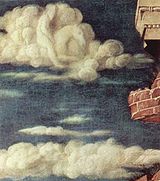
Campo Marzio
Campo Marzio, is the IV rione of Rome, which covers a smaller section of the area of the ancient Campus Martius. The logo of today's rione is a silver crescent on a blue background.-External links:*...
("Martial Field"), the painter portrayed the saint against an arch, whether a triumphal arch or the gate of the city. In 1457 the painter had been trialled for "artistical inadequacy" for having put only eight apostles in his fresco of the Assumption. As a reply, he therefore applied Alberti's Classicism
Classicism
Classicism, in the arts, refers generally to a high regard for classical antiquity, as setting standards for taste which the classicists seek to emulate. The art of classicism typically seeks to be formal and restrained: of the Discobolus Sir Kenneth Clark observed, "if we object to his restraint...
principles in the following pictures, including this small St. Sebastian, though deformed by the nostalgic perspective of his own.
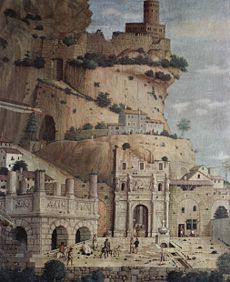
The vertical inscription at the right side of the saint is the signature of Mantegna in Greek
Greek language
Greek is an independent branch of the Indo-European family of languages. Native to the southern Balkans, it has the longest documented history of any Indo-European language, spanning 34 centuries of written records. Its writing system has been the Greek alphabet for the majority of its history;...
.
The St. Sebastian of the Louvre
The Louvre's St. Sebastian was once part of the Altar of San Zeno in VeronaVerona
Verona ; German Bern, Dietrichsbern or Welschbern) is a city in the Veneto, northern Italy, with approx. 265,000 inhabitants and one of the seven chef-lieus of the region. It is the second largest city municipality in the region and the third of North-Eastern Italy. The metropolitan area of Verona...
. In the late 17th century-early 18th century it was recorded in the Sainte Chapelle of Aigueperse
Aigueperse, Puy-de-Dôme
Aigueperse is a commune in the Puy-de-Dôme department in Auvergne in central France.-Notable people:Aigueperse was the birthplace of:* Michel de l'Hôpital Aigueperse is a commune in the Puy-de-Dôme department in Auvergne in central France.-Notable people:Aigueperse was the birthplace of:* Michel de...
, in the Auvergne
Auvergne (région)
Auvergne is one of the 27 administrative regions of France. It comprises the 4 departments of Allier, Puy de Dome, Cantal and Haute Loire.The current administrative region of Auvergne is larger than the historical province of Auvergne, and includes provinces and areas that historically were not...
region of France
France
The French Republic , The French Republic , The French Republic , (commonly known as France , is a unitary semi-presidential republic in Western Europe with several overseas territories and islands located on other continents and in the Indian, Pacific, and Atlantic oceans. Metropolitan France...
: its presence there is related to the marriage of Chiara Gonzaga, daughter of Federico I of Mantua, with Gilbert de Bourbon
Gilbert, Count of Montpensier
Gilbert de Bourbon, Count of Montpensier son of Louis de Bourbon and Gabrielle La Tour, Count of Montpensier and Dauphin d'Auvergne...
, Dauphin d'Auvergne (1486).
The picture presumably illustrates the theme of God's Athlete, inspired to a spurious sermon
Sermon
A sermon is an oration by a prophet or member of the clergy. Sermons address a Biblical, theological, religious, or moral topic, usually expounding on a type of belief, law or behavior within both past and present contexts...
by St. Augustine
Augustine of Hippo
Augustine of Hippo , also known as Augustine, St. Augustine, St. Austin, St. Augoustinos, Blessed Augustine, or St. Augustine the Blessed, was Bishop of Hippo Regius . He was a Latin-speaking philosopher and theologian who lived in the Roman Africa Province...
. The saint, again tied to a classical arch, is observed from an unusual, low perspective, used by the artist to enhance the impression of solidity and dominance of his figure. The head and eyes turned toward Heaven confirm Sebastian's firmness in bearing the martyrdom. At his feet two iniquitous people (represented by a duo of archers) are shown: these are intended to create a contrast between the man of transcendent faith, and those who are only attracted by profane pleasures.
Apart from the symbolism, the picture is characterized by Mantegna's accuracy in the depictions of ancient ruins, as well as the detail in realistic particulars such as the fig
Ficus
Ficus is a genus of about 850 species of woody trees, shrubs, vines, epiphytes, and hemiepiphyte in the family Moraceae. Collectively known as fig trees or figs, they are native throughout the tropics with a few species extending into the semi-warm temperate zone. The Common Fig Ficus is a genus of...
tree next to the column and the description of Sebastian's body.

